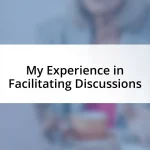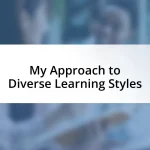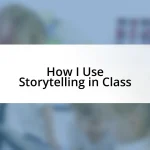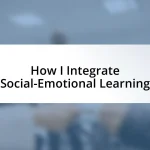Key takeaways:
- Creating safe spaces for students fosters open communication and trust, allowing them to express their thoughts more comfortably.
- Understanding influences on student behavior, such as peer relationships and home life, is crucial for recognizing underlying emotional states.
- Implementing proactive strategies, like setting clear expectations and using positive reinforcement, can significantly enhance classroom behavior and engagement.
- Active listening and empathy play vital roles in building connections with students, encouraging their participation and addressing their individual needs.
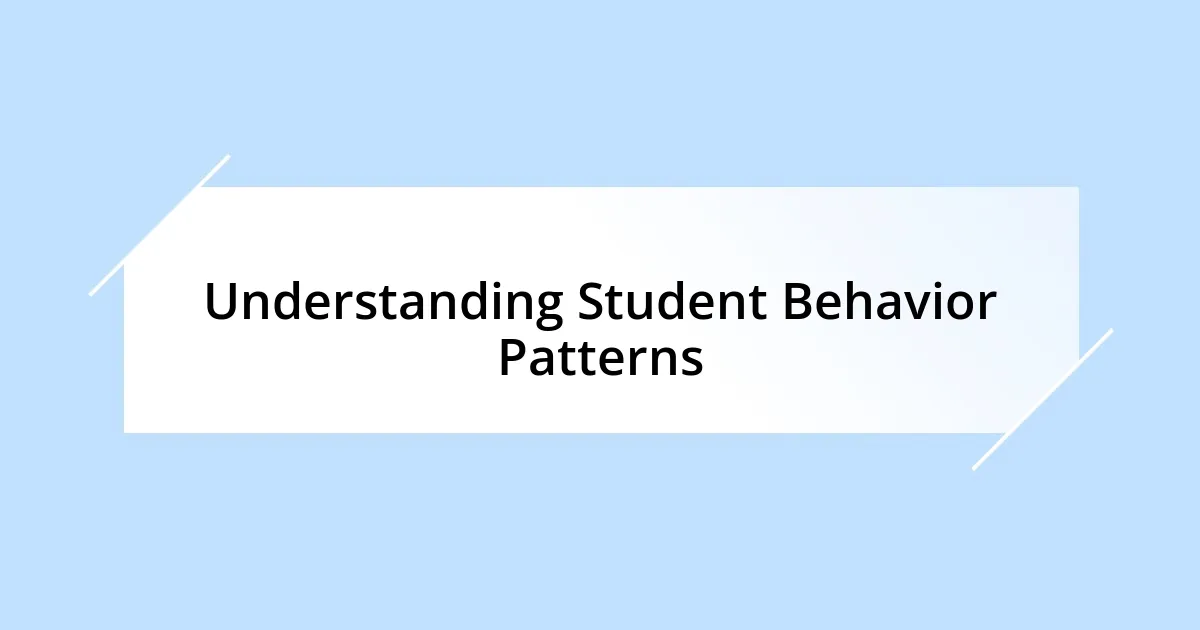
Understanding Student Behavior Patterns
Understanding student behavior patterns requires a keen eye and a touch of empathy. For instance, I once noticed a student who always excelled in written assignments but struggled during group discussions. It struck me then: what if this individual simply felt more comfortable expressing thoughts in writing? Experiencing this made me question how important it is to create safe spaces for every student to share their ideas.
I’ve learned that behavior often reflects deeper emotional states. During one project, a typically enthusiastic student became withdrawn. I reached out and discovered they were grappling with personal issues at home. This experience left me pondering—how often do we misinterpret a lack of engagement as disinterest, rather than recognizing it could stem from external pressures?
Moreover, observing how different students respond to challenges can reveal their underlying motivations. In one class, I frequently saw students who excelled in math becoming anxious when faced with creative assignments. This was a light-bulb moment for me: does their comfort in structure limit their willingness to explore ambiguity in other subjects? Understanding these nuances has profoundly shifted how I approach lessons.
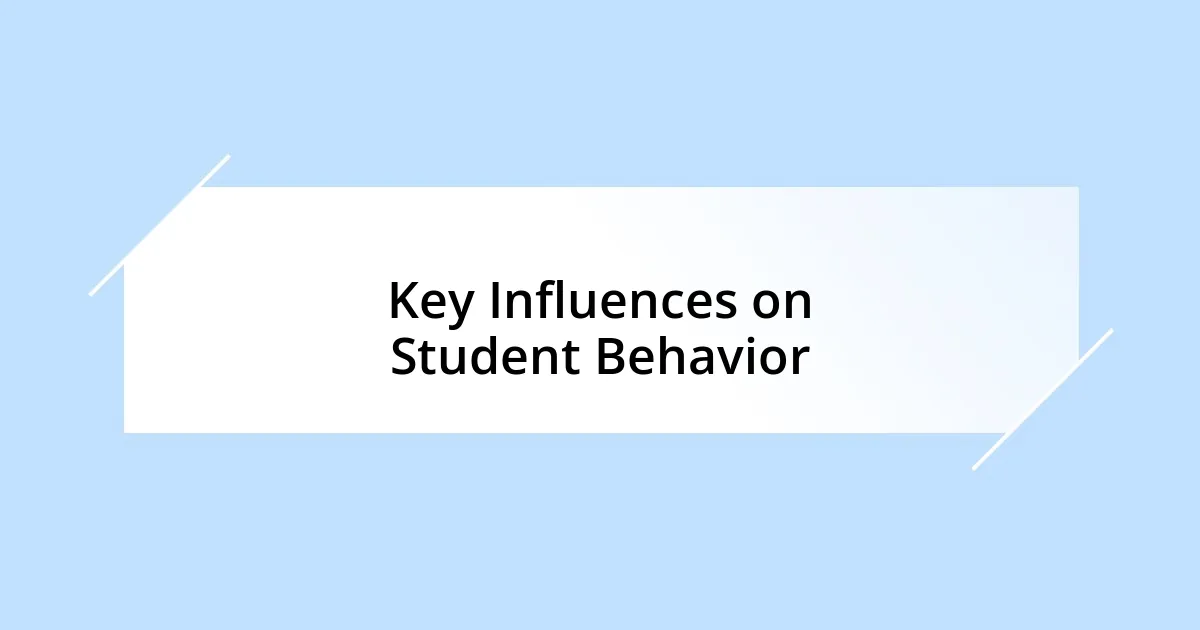
Key Influences on Student Behavior
Student behavior is profoundly influenced by a myriad of factors, including peer relationships. I once facilitated a workshop where students candidly shared the pressures they felt from their friends. It became clear that positive peer support could lead to increased participation, while negative influences often prompted withdrawal or disruptive behavior. Reflecting on this, I’ve come to appreciate just how essential a supportive classroom environment is in fostering constructive interactions.
Furthermore, I frequently observe the impact of teaching styles on student behavior. In one instance, after adopting a more interactive approach to a history lesson, student engagement skyrocketed. It was fascinating to watch my students transform from passive participants into animated debaters, sharing their viewpoints confidently. This experience reassured me that aligning teaching methods with students’ interests can significantly shape their behavior in the classroom.
Lastly, home life plays a critical role in student behavior. I remember a particular student whose grades plummeted suddenly. After a conversation, I learned that their family was going through a significant transition. It made me realize that while I often focused on academic performance, understanding the context of a student’s home life was equally crucial. Such insights have taught me to approach behavior not just as an observable action but as a reflection of the student’s life outside of school.
| Influence | Impact on Behavior |
|---|---|
| Peer Relationships | Positive relationships encourage participation, while negative ones can lead to withdrawal. |
| Teaching Styles | Interactive methods enhance engagement and encourage student expression. |
| Home Life | Personal circumstances can drastically affect students’ academic performance and behavior. |
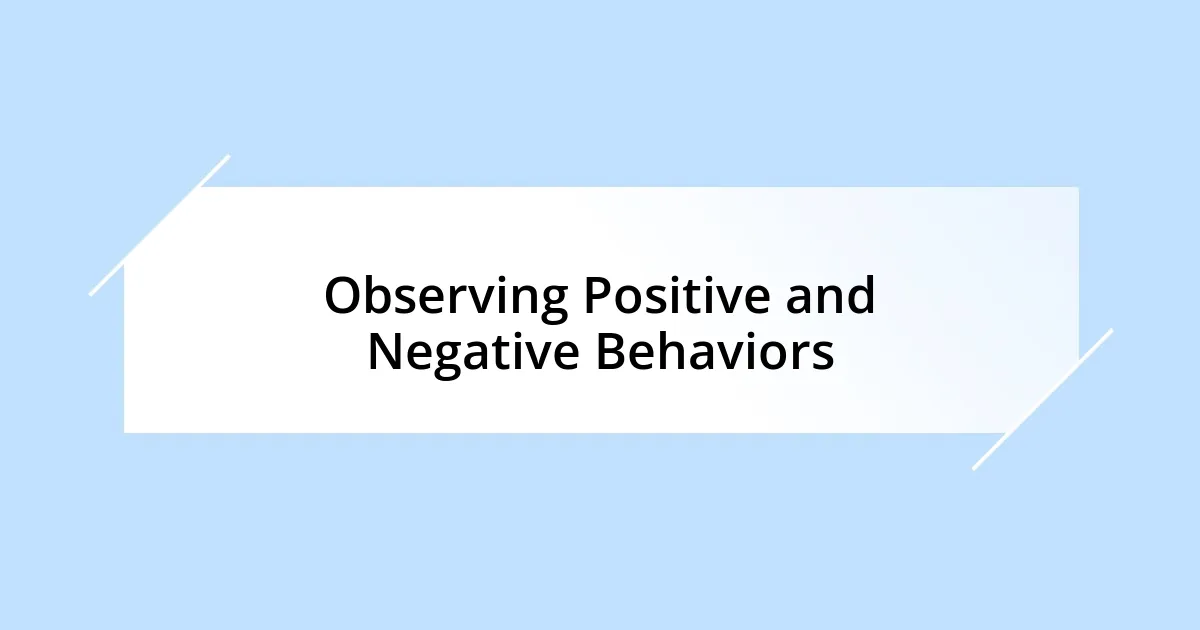
Observing Positive and Negative Behaviors
Observing both positive and negative behaviors in the classroom is like watching a spectrum of emotions and interactions unfold. I recall one day when a normally reserved student volunteered to lead the group project. The pride and confidence radiating from them was contagious, inspiring peers to engage more openly. Experiencing such uplifting moments reinforces my belief in the importance of fostering an encouraging environment.
Yet, not all behaviors are positive. I once noticed a student who usually participated readily becoming increasingly withdrawn during discussions. The shift was difficult to ignore. It reminded me how critical it is to check in with students regularly, as their emotional landscape can change rapidly. Here’s what I’ve observed regarding behaviors:
-
Positive Behaviors:
- Increased engagement during collaborative tasks.
- Volunteering for roles that involve leadership or presentation.
- Encouraging peers by celebrating their contributions, fostering a supportive atmosphere.
-
Negative Behaviors:
- Frequent daydreaming or disengagement during lessons.
- Sudden withdrawal from group activities, which may indicate personal struggles.
- Negative comments towards oneself or others that can disrupt the class dynamic.
These observations serve as a reminder that understanding behavior is about reading the room and recognizing the complex emotional layers at play.
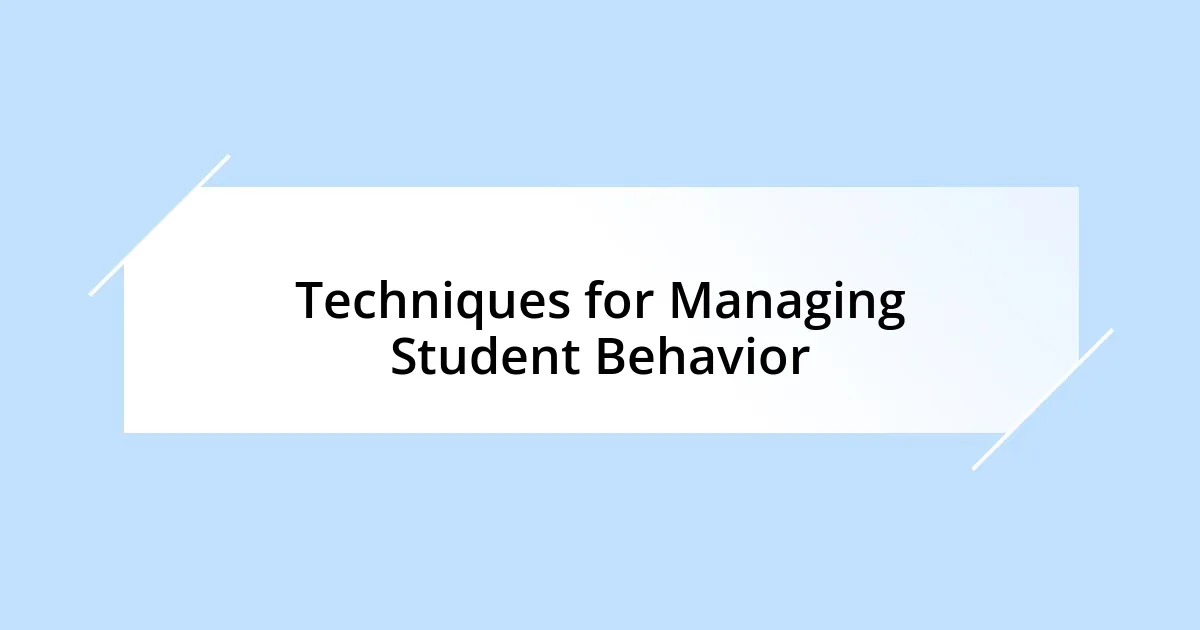
Techniques for Managing Student Behavior
When it comes to managing student behavior, one technique that I’ve found particularly effective is establishing clear expectations right from the start. Early in my career, I created a simple classroom contract with my students, detailing behaviors we would all commit to—everything from respect during discussions to raising hands before speaking. You know what? This proactive approach not only empowered the students but also fostered a sense of ownership over their own behavior. How often do we overlook the power of setting boundaries?
Another technique that has made a difference is incorporating frequent check-ins with students. I remember a time when I started a routine where, at the end of each week, I’d ask students to reflect on their experiences—like what worked well and what didn’t. It was intriguing to see how this practice opened up dialogues about their feelings and behaviors in class. Students began to feel like their voices mattered, and it led to more honest expressions of their struggles. This simple act of listening went a long way in reducing misunderstandings and conflicts.
Positive reinforcement can also be a game changer. I recall one student who struggled to stay focused during lessons but started showing improvement after I acknowledged his small victories, like participating in group discussions. The transformation was remarkable! Instead of feeling frustrated, he felt motivated. This experience underscored for me that recognizing even the tiniest steps forward can create a ripple effect on overall classroom behavior. How often do we stop to celebrate these little wins? In my experience, they’re more important than we realize.
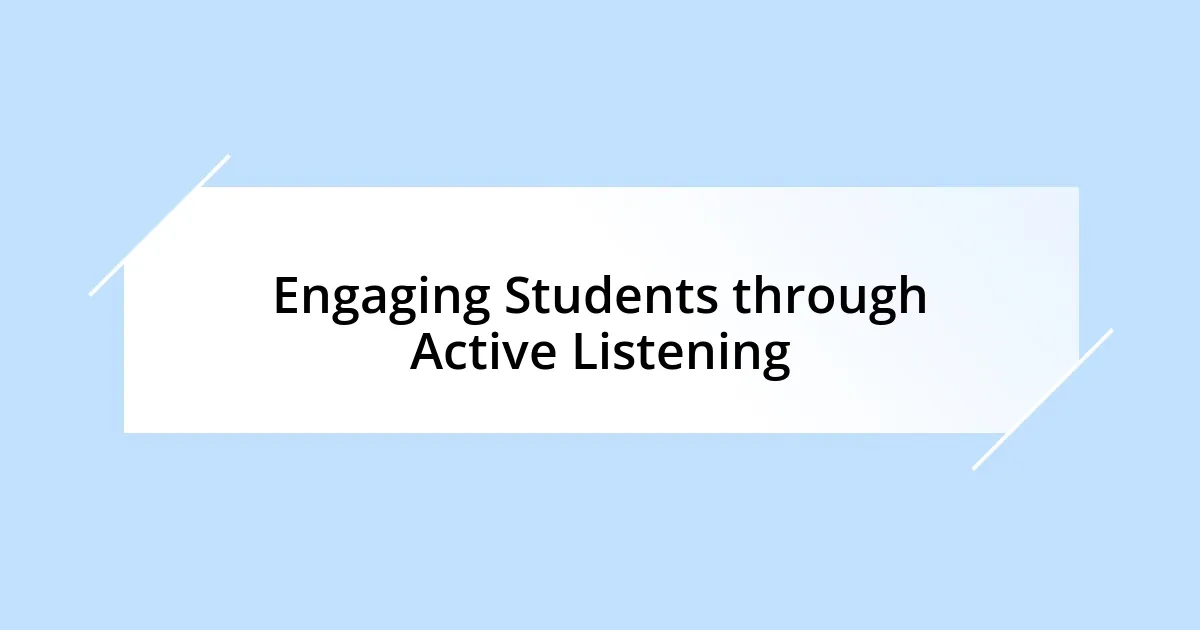
Engaging Students through Active Listening
Engaging students through active listening has been a transformative experience for me. I remember a moment in class when a student shared a personal challenge related to their family life. Instead of merely nodding or providing advice, I took a moment to reflect back what they said, creating an immediate connection. The gratitude in their eyes spoke volumes. It made me realize how powerful it is to actively listen, showing students that their feelings are valid and recognized.
I often find that holding space for student voices encourages deeper engagement. I once implemented a weekly forum where students could discuss topics important to them—anything from school policies to social issues. The first time, I was amazed by the depth of conversation that emerged, revealing insights I’d never anticipated. They weren’t just sharing opinions; they were excited to know someone was genuinely interested. Have you ever witnessed the shift in energy when students feel heard? It’s palpable, and it reaffirms the role of active listening in building trust and promoting a sense of belonging.
Active listening goes beyond merely hearing words; it requires empathy and an open heart. There was a time I misjudged a quiet student’s silence as disinterest. After probing deeper, I learned about their struggles with anxiety. By listening and asking questions instead of assuming, I could tailor my approach to meet their specific needs. This taught me a valuable lesson: engaging students isn’t solely about what we teach them, but how we make them feel. When was the last time you truly listened to someone in your class? I challenge you to reflect on that and consider the impact it could have on fostering genuine connections.
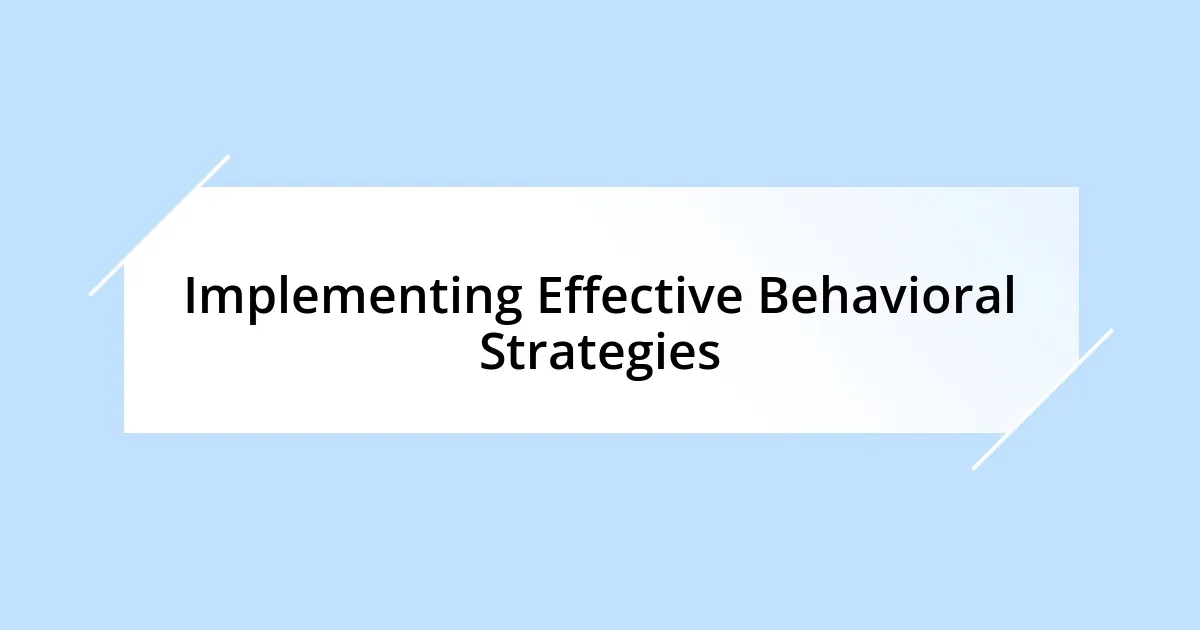
Implementing Effective Behavioral Strategies
Implementing effective behavioral strategies requires consistency in approach. For instance, I once developed a rewards system for positive behavior and noticed how quickly it transformed the dynamic of my classroom. Students weren’t just striving for grades; they were genuinely excited to earn recognition for behaving respectfully or helping their peers. Isn’t it fascinating how a little incentive can shift attitudes?
Another pivotal strategy is modeling expected behavior. I vividly remember a time when I made a mistake in class, accidentally raising my voice while trying to get everyone’s attention. Instead of brushing it off, I took a moment to apologize and explain why staying calm is important. By owning my mistake, I demonstrated accountability and encouraged my students to do the same. Hasn’t there been a moment when you’ve realized that your actions can speak louder than your words?
Also, fostering a sense of community can greatly influence student behavior. I decided to create small groups for collaborative projects and was amazed at how bonds formed among students who previously hardly interacted. Watching them support each other, celebrate successes, and tackle challenges together reinforced my belief that when students feel they belong, their behavior naturally aligns with positive classroom culture. It’s inspiring to see how connection can enhance responsibility and engagement—don’t you think that sense of belonging is something we all crave?
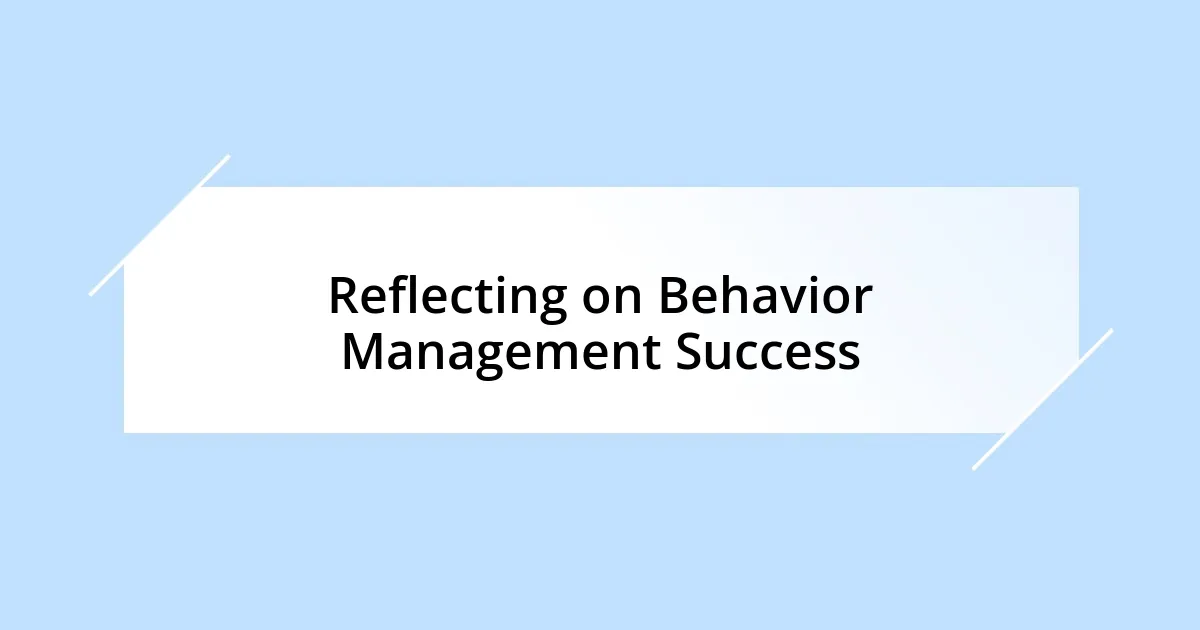
Reflecting on Behavior Management Success
Reflecting on behavior management success is an enlightening journey for any educator. I recall a particular semester when I emphasized the importance of self-reflection among my students. I set aside time during class for them to think about their actions and their impacts, and the transformation was remarkable. Many students began to take ownership of their behavior, realizing it wasn’t just about following rules but about how they contributed to our classroom community. Have you ever noticed how simply allowing students to reflect can lead to profound changes in their demeanor?
There was a time when I struggled with a few disruptive behaviors in class, which led me to rethink my approach. Instead of focusing solely on discipline, I shifted to fostering emotional intelligence through guided discussions on feelings and consequences. This approach not only decreased the disruptions but also cultivated empathy among my students. When they began to understand how their actions could affect others, I witnessed a significant drop in negative behaviors. Doesn’t it amaze you how teaching emotions can potentially reshape a classroom environment?
One particular success story stands out in my mind. I worked with a student who often challenged authority. Instead of responding with frustration, I took the time to understand his background and the reasons for his behavior. By engaging him in one-on-one dialogues where he could express his thoughts, I was able to guide him toward more constructive choices. That emotional investment made all the difference; he transformed from a disruptive presence to an active participant in class. Isn’t it remarkable how understanding a student’s story can unlock the potential for positive change?
